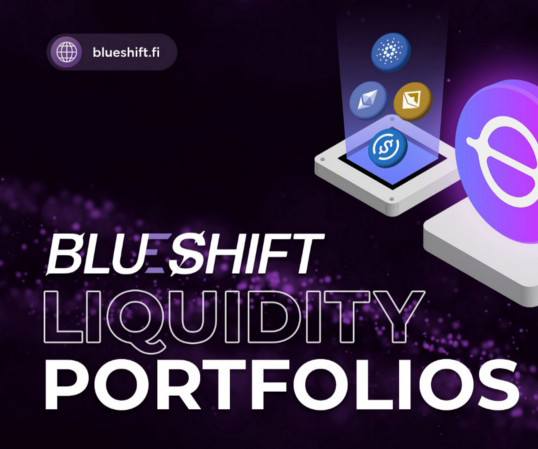Liquidity Portfolios
Apr 6, 2022


DeFi 1.0 has been dominated by liquidity pools that mostly consist of a single token pair. As the ecosystem and the technology have further developed, liquidity pools’ inherent drawbacks have become a burden to DeFi users. The idea of token pairs utilized as a liquidity pool required a fundamental overhaul.
To enable mainstream adoption and truly catalyze the manifestation of DeFi 2.0, a paradigm shift is inevitable. Liquidity pools have to be technologically improved or even reinvented — while providing maximum user convenience.
Enter liquidity portfolios (LPs).
Liquidity portfolios are the fuel to an ecosystem that is ready to lift off. By restructuring the very core of liquidity pools and introducing liquidity portfolios, Blueshift has managed to materialize numerous improvements that have been lacking in the old world of DeFi 1.0. Dozens of cryptocurrencies can be contained within liquidity portfolios while users can only provide a single token as Liquidity.
Moreover, crypto users can now also acquire a selection, just one, or all of the assets present in a Liquidity Portfolio.
By providing a single type of cryptocurrency to liquidity portfolios, crypto users can now get LP fees without being burdened by significant impermanent loss!
For Blueshift Liquidity Providers, Impermanent loss has become a nuisance rather than a serious issue as they get a two to ten times reduction in impermanent losses by using Blueshift!
Aside from technological improvements, liquidity portfolios will offer convenience to newbies and crypto veterans alike. Users will now be able to invest in portfolios that represent:
- Indexes, such as tokens of “top 10 ecosystems” or “metaverse”
- Verticals, such as gaming, football, music, or education
- Organizations, that have their own branded portfolios with bundled tokens
- Technologies, such as oracles, smart contracts, AR/VR, or NFTs
- Special tokens, such as newcomers or rising stars
Likewise, there will also be blockchain-specific portfolios, such as for Cardano, incl. ADA, BLUES, PAVIA, WMT, OCX, REVU, MILK, GRASS, MILKY, VYFI, Liquid, MELD, MINt, HOSKY, SUNDAE, XRAY, and DANA, for example.
As new vetted and upcoming Cardano projects rise and issue their token, they will be added to the ‘Cardano’ Liquidity portfolio — after a community decision. A single Liquidity Portfolio can contain from 2 up to approximately 40 different tokens or cryptocurrencies.
The 40 token limit is not derived from technical limitations, but rather is derived from practical reasons, and hence — this limit is not absolute and is subject to change.
It is important to understand that users will be able to build their own Liquidity Portfolios, however, this feature will only be utilizable by advanced users, as it is inaccessible via the UI.
Liquidity portfolios and related features
Liquidity portfolios are likewise combined with several other very useful and unique Blueshift features, which will help this new concept to realize its full potential.
First and foremost, the holders of shares of various liquidity portfolios will benefit from professional portfolio management.
Liquidity Portfolios’ managers
The concept of integrating professional liquidity portfolio managers’ expertise functions in the following way: firstly the community selects Blueshift DAO councillors.
Blueshift DAO councillors then whitelist a professional portfolio manager, or a group of managers, whereby the manager or managers will propose changes to liquidity portfolios, on which the community will vote on again — via the DAO.
Portfolio managers will provide advice to protect a portfolio from low-quality assets as well as advice to add new assets with high growth potential.
Blueshift’s DAO will, however, be used in more than one way — to launch liquidity portfolios beyond the horizon of what we now perceive as possible.
DAO
The community will have oversight of the liquidity portfolios as well as its parameters and managers through a fully-fledged DAO. The weight of each individual’s vote in DAO votes depends on the stake of BLUES tokens that the individual has.
In other words, possessing BLUES tokens will allow individuals to not only influence the selection of cryptocurrencies that liquidity portfolios are composed of — but also other parameters as well.
Virtual Pairs
Virtual pairs replace the standard use of DeFi 1.0 trading pairs. During a swap, virtual pairs are constructed to minimize impermanent loss and price slippage.
Virtual pairs are virtual cryptocurrency pairs that do not exist permanently on the Blueshift platform. They are created dynamically to accommodate a user’s swap.
The CeFi equivalent of virtual pairs are so-called “synthetic pairs”.
Both synthetic and virtual pairs do not exist permanently on platforms, however, they are created and can be utilized — by combining multiple pairs into one single pair.
Example pairs:
ADA<>BLUES
BLUES<>ETH
ETH<>AGIX
By combining these pairs, we get a virtual pair ADA<>AGIX, that might have a different and better price for either ADA or AGIX compared to the standard ADA<>AGIX pair.
The creation of the optimal virtual pairs, providing key benefits to Blueshift users, is largely affected by Blueshift’s Reserve Model which facilitates arbitrage with reduced reserves.
Blueshift Reserve Model
The Blueshift Reserve Model enables arbitrageurs to opt-in for the utilization of reduced reserves during an arbitrage — in exchange for a reduced trading fee, or even a negative trading fee.
Utilization of reduced reserves whilst performing a trade increases slippage for the arbitrageur, however, due to forfeiture of the arbitrage fee by the platform itself — arbitrages in such conditions will commonly result in a net positive trade.
Since such a concept implies that a net positive arbitrage can occur when a price difference is less than 0,3 % between assets, as that is the trading fee that is being forfeited, the Blueshift team expects high utilization, and consequently high benefits for Liquidity Providers.
Aside from benefits provided to Arbitrageurs, Liquidity Providers gain through this mechanism as their Impermanent Losses are significantly reduced when Arbitrageurs utilize the Blueshift’s Reserve Model.

